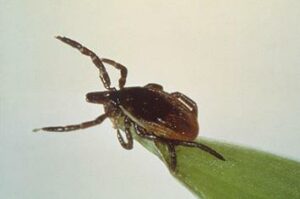Pest Alert – Ticks in the Landscape
go.ncsu.edu/readext?857358
en Español / em Português
El inglés es el idioma de control de esta página. En la medida en que haya algún conflicto entre la traducción al inglés y la traducción, el inglés prevalece.
Al hacer clic en el enlace de traducción se activa un servicio de traducción gratuito para convertir la página al español. Al igual que con cualquier traducción por Internet, la conversión no es sensible al contexto y puede que no traduzca el texto en su significado original. NC State Extension no garantiza la exactitud del texto traducido. Por favor, tenga en cuenta que algunas aplicaciones y/o servicios pueden no funcionar como se espera cuando se traducen.
Português
Inglês é o idioma de controle desta página. Na medida que haja algum conflito entre o texto original em Inglês e a tradução, o Inglês prevalece.
Ao clicar no link de tradução, um serviço gratuito de tradução será ativado para converter a página para o Português. Como em qualquer tradução pela internet, a conversão não é sensivel ao contexto e pode não ocorrer a tradução para o significado orginal. O serviço de Extensão da Carolina do Norte (NC State Extension) não garante a exatidão do texto traduzido. Por favor, observe que algumas funções ou serviços podem não funcionar como esperado após a tradução.
English
English is the controlling language of this page. To the extent there is any conflict between the English text and the translation, English controls.
Clicking on the translation link activates a free translation service to convert the page to Spanish. As with any Internet translation, the conversion is not context-sensitive and may not translate the text to its original meaning. NC State Extension does not guarantee the accuracy of the translated text. Please note that some applications and/or services may not function as expected when translated.
Collapse ▲Although there are several ticks that parasitize people and animals, the deer tick is the most concerning. Ixodes (Deer) ticks are much smaller than common dog and cattle ticks. In their larval and nymphal stages, deer ticks are no bigger than a pinhead.
Ticks feed by inserting their mouths into the skin of a host and slowly take in blood. Deer ticks are most likely to transmit Lyme disease infection after feeding for two or more days. Therefore it is important to quickly get ticks off of your person. There is no Lyme disease vaccine available.
How to Reduce Tick Exposure
- Avoid tick habitats such as scrubby woodlands and with thick undergrowth.
- Use DEET insecticides on your clothing to prevent tick exposure when in the woods.
- Reduce tick abundance by removing groundcover plants from areas of activities such as walking paths, gardens and landscapes.
- Mulch a border between lawns and surrounding woods.
- Deer ticks are parasites that infest wildlife. Ticks fall from wild animals in yards and woodlands. Discouraging wildlife from hanging around your yard prevents ticks from being deposited in your areas of activity. Do not feed deer. Bring in bird feeders at night to discourage all the night creatures such as racoons.
- The best way to rid your yard of ticks is to treat an outdoor pet such as a dog or cat with flea and tick treatments that contain fipronil (Frontline). The ticks get on the pet, feed on their blood that has the pesticide in it and then the ticks die. Basically the pet acts as a trap for ticks.
- If you do not have a pet, then treating the surrounding woodland edge and landscape plants with an insecticide such as bifenthrin can help. This of course is not good for beneficial insects such as bees and butterflies so follow labelled directions and use caution. Spray early in the morning or late in the day to avoid the active hours of beneficial insects.
- Keep lawns mowed and prune limbs from trees and shrubs that might touch people when they are in the landscape.
- Use tick repellents as directed.
- Perform a tick check of your entire body after every outdoor activity and remove attached ticks.
- Learn how to identify ticks.





